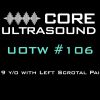19 y/o WF presents with c/o months of intermittent episodes of postprandial abdominal distention, pain and severe n/v. She states that she has been to the ER several times for this before and “always gets an NG tube,” resolving the episodes. On exam, the pt has moderate firm upper abdominal distension and tenderness. Your initial abdominal ultrasound reveals a very large, full stomach. After an NG tube is placed you obtain the following clip.

Answer: Superior Mesenteric Artery (SMA) Syndrome
The patient presents with a history classic, albeit nonspecific, for SMA syndrome: recurrent postprandial distension and vomiting. The stomach was quite distended on physical exam, confirmed with ultrasound. The subsequent ultrasound clip demonstrates a sagittal view of a normal appearing aorta. However, upon closer inspection it is noted that the aortomesenteric angle (e.g., the angle between the SMA and the aorta) is rather acute. This finding confirms the diagnosis of SMA syndrome in this clinical setting.
- SMA syndrome is a rare condition whereby the third (transverse) portion of the duodenum is mechanically blocked by the narrow angle between the SMA and the aorta. This results in proximal obstruction.1
- One study of >900 patients with dyspepsia demonstrated an SMA syndrome incidence of 3% in this cohort.2
- A normal aortomesenteric angle is approximately 45 degrees, and an aortomesenteric angle of 6-25 degrees confirms the diagnosis of SMA syndrome. This angle can be readily measured on CT, MRI, angiogram, or ultrasound.3-7
- To measure the aortomesenteric angle, first obtain a sagittal view of the aorta and sort out your landmarks: aorta (Ao), celiac artery (CA), and superior mesenteric artery (SMA). Measure the SMA angle as it takes off from the aorta.

- Additionally, a normal aortomesenteric distance is 10-28 mm. An aortomesenteric distance <8-10mm would suggest SMA syndrome in the appropriate clinical setting.3-7

- Initial management of SMA syndrome involves relieving the proximal obstruction via nasogastric tube decompression.
- If conservative measures are not effective, or if the patient has severe recurrent symptoms they should be referred for surgical intervention. A duodenojejunostomy or gastrojejunostomy can be curative.
- Merrett ND, Wilson RB, Cosman P, Biankin AV. Superior mesenteric artery syndrome: diagnosis and treatment strategies. J Gastrointest Surg. 2009;13(2):287-92. [pubmed]
- Neri S, Signorelli SS, Mondati E, et al. Ultrasound imaging in diagnosis of superior mesenteric artery syndrome. J Intern Med. 2005;257(4):346-51. [pubmed]
- Hines JR, Gore GM, Ballantyne GH. Superior mesenteric artery syndrome. Am J Surg 1984; 148: 630–4. [pubmed]
- Ahmed AR, Taylor I. Superior mesenteric artery syndrome. Postgrad Med J 1997; 73: 776–8. [pubmed]
- Bedoya R, Lagman SM, Pennington GP, Kirdnual A. Clinical and radiological aspects of the superior mesenteric artery syndrome. J Fla Med Assoc 1986; 73: 686–9. [pubmed]
- Duvie SOA. Anterior transposition of the third part of the duodenum in the management of chronic duodenal com- pression by the superior mesenteric artery. Int Surg 1988; 73: 140–3. [pubmed]
- Van Brussel JP, Dijkema WP, Dhin SK, Jonkers GJPM. Wilkie’s syndrome, a rare cause of vomiting and weight loss: diagnosis and therapy. J Med 1997; 51: 179–81. [pubmed]




